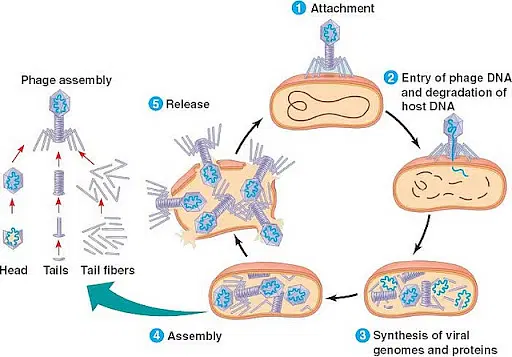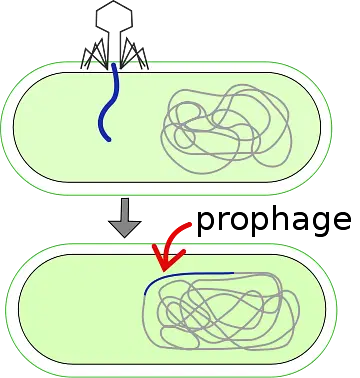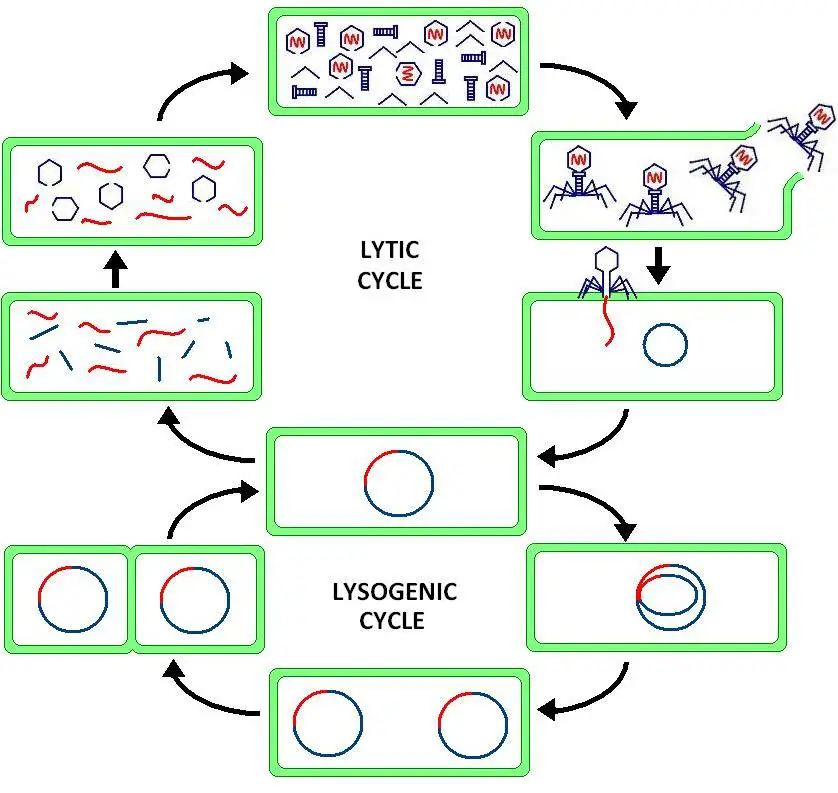Table of Contents
What is Lytic Cycle?
The lytic cycle is a fundamental process in the life cycle of certain viruses, particularly bacteriophages, which are viruses that infect bacteria. This cycle is characterized by the following sequential events:
- Attachment: Initiated when a virulent phage recognizes and binds to specific receptors on the bacterial surface. These receptors can be lipopolysaccharides, OmpC proteins, or other surface molecules. The specificity of this interaction determines the host range of the phage, meaning which bacterial species or strains it can infect.
- Penetration: Following attachment, the phage introduces its genetic material into the bacterial cell. This is achieved through the contraction of the phage’s tail sheath, which functions analogously to a hypodermic syringe, piercing the bacterial cell wall and membrane. Notably, only the viral genome enters the host, leaving the phage’s capsid and other structural components outside.
- Transcription and Biosynthesis: Once inside, the phage commandeers the host’s cellular machinery. The bacterial chromosome is degraded by viral endonucleases, ensuring that the host’s resources are dedicated to viral replication. The viral genome is then transcribed and translated, leading to the production of viral RNA or DNA and proteins. This biosynthesis occurs in phases: the early phase involves modifying host RNA transcription, the middle phase focuses on nucleic acid replication, and the late phase produces the necessary proteins for new virions.
- Maturation: Newly synthesized viral components are assembled into complete virions within the bacterial cell. This involves packaging the viral genome into capsids and attaching structural elements like tails.
- Lysis: The culmination of the lytic cycle is the release of newly formed virions. Viral proteins compromise the bacterial cell wall, causing the cell to burst or lyse. This releases the progeny virions, which are free to infect new cells and perpetuate the cycle.
The term “lytic” is derived from “lysis,” referring to the rupture and death of the host cell. This cycle contrasts with the lysogenic cycle, where the viral genome integrates into the host DNA and remains dormant. The lytic cycle is rapid and results in the production of numerous virions in a short time frame, underscoring its efficiency as a viral replication strategy.

What is Lysogenic Cycle?
The lysogenic cycle represents one of the two primary pathways of viral reproduction, the other being the lytic cycle. In the lysogenic cycle, the viral genome integrates into the host’s DNA, allowing the virus to propagate without immediately causing harm to the host.
- Integration: In the initial phase of the lysogenic cycle, the virus introduces its DNA into the host cell. Rather than taking over the host’s machinery for immediate replication, as seen in the lytic cycle, the viral DNA integrates into the host’s genome. This integrated viral DNA is termed a “prophage.”
- Replication: Once integrated, the prophage remains dormant within the host’s genome. As the host cell undergoes its regular DNA replication processes, the prophage is also replicated. This ensures the propagation of the viral genome without the immediate destruction of the host cell.
- Lysogenic Conversion: The presence of the prophage can alter the host cell’s characteristics. This phenomenon, known as lysogenic conversion, can lead to the expression of new traits in the host, often enhancing its virulence. For instance, certain bacterial strains become more pathogenic due to the genes introduced by the prophage.
- Induction: Under specific conditions, the prophage can be excised from the host genome, leading to the activation of the lytic cycle. This process, known as induction, results in the production of new virions and the eventual lysis of the host cell.
- Persistence and Propagation: The primary advantage of the lysogenic cycle is its ability to maintain the viral genome within the host for extended periods. This persistence allows the virus to propagate without eliciting an immediate immune response or causing rapid host cell death.
Lambda phage serves as a quintessential example of a virus that undergoes the lysogenic cycle. Upon infecting its bacterial host, the lambda phage can integrate its genome into the bacterial DNA, becoming a prophage. As the bacterium replicates, so does the prophage. However, under certain conditions, the lambda phage can transition from the lysogenic to the lytic cycle, leading to the production of new phage particles and the destruction of the host bacterium.

In summary, the lysogenic cycle offers a strategic advantage for viruses, allowing them to coexist with their hosts, propagate silently, and under certain triggers, shift to the lytic cycle for rapid multiplication and spread.
Difference Between Lytic and Lysogenic Cycle
The lytic and lysogenic cycles are two distinct pathways of viral reproduction in bacteria, primarily involving bacteriophages. These cycles differ in their approach to replication and their impact on the host cell. Here, we elucidate the differences between the lytic and lysogenic cycles based on the provided tables:

- Integration of Viral DNA:
- Lytic Cycle: The viral DNA remains separate and does not integrate into the host DNA.
- Lysogenic Cycle: The viral DNA integrates into the host DNA, becoming a part of the host’s genome.
- Host DNA Hydrolysis:
- Lytic Cycle: The host DNA is hydrolyzed.
- Lysogenic Cycle: The host DNA remains intact and is not hydrolyzed.
- Prophage Stage:
- Lytic Cycle: There is an absence of the prophage stage.
- Lysogenic Cycle: The prophage stage is present, marking the integration of the viral genome into the host DNA.
- DNA Replication:
- Lytic Cycle: The viral DNA replicates independently of the host DNA replication.
- Lysogenic Cycle: The viral DNA replication occurs concurrently with the host DNA replication.
- Duration:
- Lytic Cycle: The process occurs within a short period, leading to rapid viral replication and host cell lysis.
- Lysogenic Cycle: The process can be extended, with the virus remaining dormant within the host cell for variable durations.
- Symptoms and Genetic Recombination:
- Lytic Cycle: Symptoms of viral replication are evident, and genetic recombination in the host bacterium is not permitted.
- Lysogenic Cycle: Symptoms of viral replication are not immediately evident, and genetic recombination in the host bacterium is allowed.
- Cellular Impact:
- Lytic Cycle: The cellular mechanism of the host is entirely overtaken by the viral genome, leading to cell destruction.
- Lysogenic Cycle: The cellular mechanism of the host is partially disrupted by the viral genome, but the host cell initially survives.
- Resultant Viruses:
- Lytic Cycle: Newly formed viruses are released immediately after replication and assembly.
- Lysogenic Cycle: The virus can remain dormant within the host cell for extended periods before activation.
- Environmental Triggers:
- Lytic Cycle: The cycle is not dependent on external factors.
- Lysogenic Cycle: The cycle can be activated by environmental stress, specific signals, or other cues.
- Impact on Host Organism:
- Lytic Cycle: Typically results in acute infections with rapid onset of symptoms, damaging and killing the host cell.
- Lysogenic Cycle: Can lead to latent infections with periods of viral activity and dormancy. The integrated viral DNA may confer new functions or traits to the host cell.
- Examples:
- Lytic Cycle: Influenza and the common cold are examples of viruses that predominantly follow the lytic cycle.
- Lysogenic Cycle: HIV and herpes virus are examples of viruses that can undergo the lysogenic cycle.
In summary, while the lytic cycle is characterized by the rapid replication and release of viruses leading to the destruction of the host cell, the lysogenic cycle involves the integration of the viral genome into the host DNA, allowing for a more prolonged interaction with the host without immediate destruction.
Lytic vs Lysogenic Cycle Table Chart
| Criteria | Lytic Cycle | Lysogenic Cycle |
|---|---|---|
| Integration of Viral DNA | Does not integrate into the host DNA. | Integrates into the host DNA. |
| Host DNA Hydrolysis | Host DNA is hydrolyzed. | Host DNA remains intact. |
| Prophage Stage | Absent. | Present. |
| DNA Replication | Independent of host DNA replication. | Occurs concurrently with host DNA replication. |
| Duration | Short period. | Extended, variable duration. |
| Symptoms and Genetic Recombination | Symptoms evident; no genetic recombination in host. | Symptoms not immediately evident; genetic recombination in host allowed. |
| Cellular Impact | Host cell is overtaken and destroyed. | Host cellular mechanism is partially disrupted; cell initially survives. |
| Resultant Viruses | Released immediately after replication and assembly. | Can remain dormant within the host for extended periods. |
| Environmental Triggers | Not dependent on external factors. | Activated by environmental stress, specific signals, or other cues. |
| Impact on Host Organism | Acute infections with rapid symptoms; host cell destroyed. | Latent infections with periods of activity and dormancy; may confer new functions/traits to the host. |
| Examples | Influenza, common cold. | HIV, herpes virus. |
Similarities between the lytic and lysogenic cycles
The lytic and lysogenic cycles are two primary pathways through which viruses reproduce and propagate. Despite their distinct mechanisms and outcomes, these cycles share several fundamental similarities rooted in their overarching goal: viral replication. Here, we delineate the commonalities between the lytic and lysogenic cycles:
- Nature of Replication: Both the lytic and lysogenic cycles are mechanisms centered on viral replication. They represent the virus’s strategies to ensure its survival and proliferation within a host.
- Host Dependency: Both cycles are intracellular processes, meaning they can only transpire within host cells. The virus relies on the host’s cellular machinery to facilitate its replication, whether it’s immediate, as in the lytic cycle, or delayed, as in the lysogenic cycle.
- Rapid Reproduction Potential: Both cycles have the capability to produce vast numbers of viral progeny in a relatively short timeframe. While the lytic cycle is typically more immediate in its replication and release, the lysogenic cycle, upon activation, can shift to the lytic mode and produce copious viral particles.
- Initiation via Host Receptors: The inception of both cycles is contingent on the virus recognizing and binding to specific receptors on the host cell. This receptor-mediated interaction ensures the specificity of the virus to its host and initiates the subsequent steps of either the lytic or lysogenic pathway.
- Involvement in Viral Life Cycle: Both the lytic and lysogenic cycles are integral components of the viral life cycle. They represent alternative strategies that the virus can employ based on environmental conditions, host availability, and other factors.
In essence, while the lytic and lysogenic cycles differ in their approach and consequences for the host, they are unified in their objective: to ensure the survival, replication, and dissemination of the virus. Both pathways underscore the adaptability and intricacy of viral reproductive strategies within host organisms.
Quiz
Which cycle results in the immediate destruction of the host cell?
a) Lysogenic Cycle
b) Lytic Cycle
c) Both
d) Neither
In which cycle does the viral DNA integrate into the host’s genome?
a) Lysogenic Cycle
b) Lytic Cycle
c) Both
d) Neither
Which cycle can potentially confer new traits to the host bacterium due to the integration of viral DNA?
a) Lysogenic Cycle
b) Lytic Cycle
c) Both
d) Neither
Which cycle is characterized by rapid replication and release of viruses?
a) Lysogenic Cycle
b) Lytic Cycle
c) Both
d) Neither
In which cycle can the virus remain dormant within the host cell for extended periods?
a) Lysogenic Cycle
b) Lytic Cycle
c) Both
d) Neither
Which cycle involves the production of a prophage stage?
a) Lysogenic Cycle
b) Lytic Cycle
c) Both
d) Neither
In which cycle does the viral DNA remain separate and not integrate into the host DNA?
a) Lysogenic Cycle
b) Lytic Cycle
c) Both
d) Neither
Which cycle can shift to the other under specific conditions or triggers?
a) Lysogenic Cycle
b) Lytic Cycle
c) Both
d) Neither
In which cycle is the host cell’s machinery entirely overtaken by the viral genome, leading to cell destruction?
a) Lysogenic Cycle
b) Lytic Cycle
c) Both
d) Neither
Which cycle can lead to latent infections with periods of viral activity and dormancy?
a) Lysogenic Cycle
b) Lytic Cycle
c) Both
d) Neither
FAQ
What is the primary difference between the lytic and lysogenic cycles?
The lytic cycle leads to the destruction of the host cell, releasing new viruses, while the lysogenic cycle involves the integration of the viral DNA into the host’s genome without immediate destruction of the host cell.
Can a virus switch between the lytic and lysogenic cycles?
Yes, certain viruses, known as temperate viruses, can switch from the lysogenic cycle to the lytic cycle under specific conditions or triggers.
Why is it called the “lytic” cycle?
It’s named after the process of “lysis,” where the host cell is destroyed or lysed, releasing new virus particles.
Do all viruses undergo both lytic and lysogenic cycles?
No, only temperate viruses can undergo both cycles. Some viruses exclusively undergo the lytic cycle.
How does the lysogenic cycle benefit the virus?
The lysogenic cycle allows the virus to remain dormant within the host cell, evading the host’s immune response and potentially spreading the viral DNA each time the host cell divides.
What triggers a virus in the lysogenic cycle to enter the lytic cycle?
Various factors, including environmental stress, radiation, or specific chemicals, can induce the prophage (viral DNA in the host genome) to initiate the lytic cycle.
Are there any benefits to the host during the lysogenic cycle?
In some cases, the integrated viral DNA can confer new traits to the host bacterium, which might offer a selective advantage. This phenomenon is known as lysogenic conversion.
What happens to the viral capsid during the lysogenic cycle?
During the lysogenic cycle, the viral capsid remains outside the host cell, and only the viral nucleic acid integrates into the host’s genome.
Can a bacterium infected in the lysogenic cycle produce symptoms in the host organism?
Typically, during the lysogenic cycle, symptoms are not evident. However, when the virus gets activated and enters the lytic cycle, symptoms can manifest.
How is the decision made between the lytic and lysogenic cycles upon viral infection?
The decision is often influenced by environmental factors and the physiological state of the host cell. Specific regulatory proteins in the virus play a role in determining the pathway taken.
